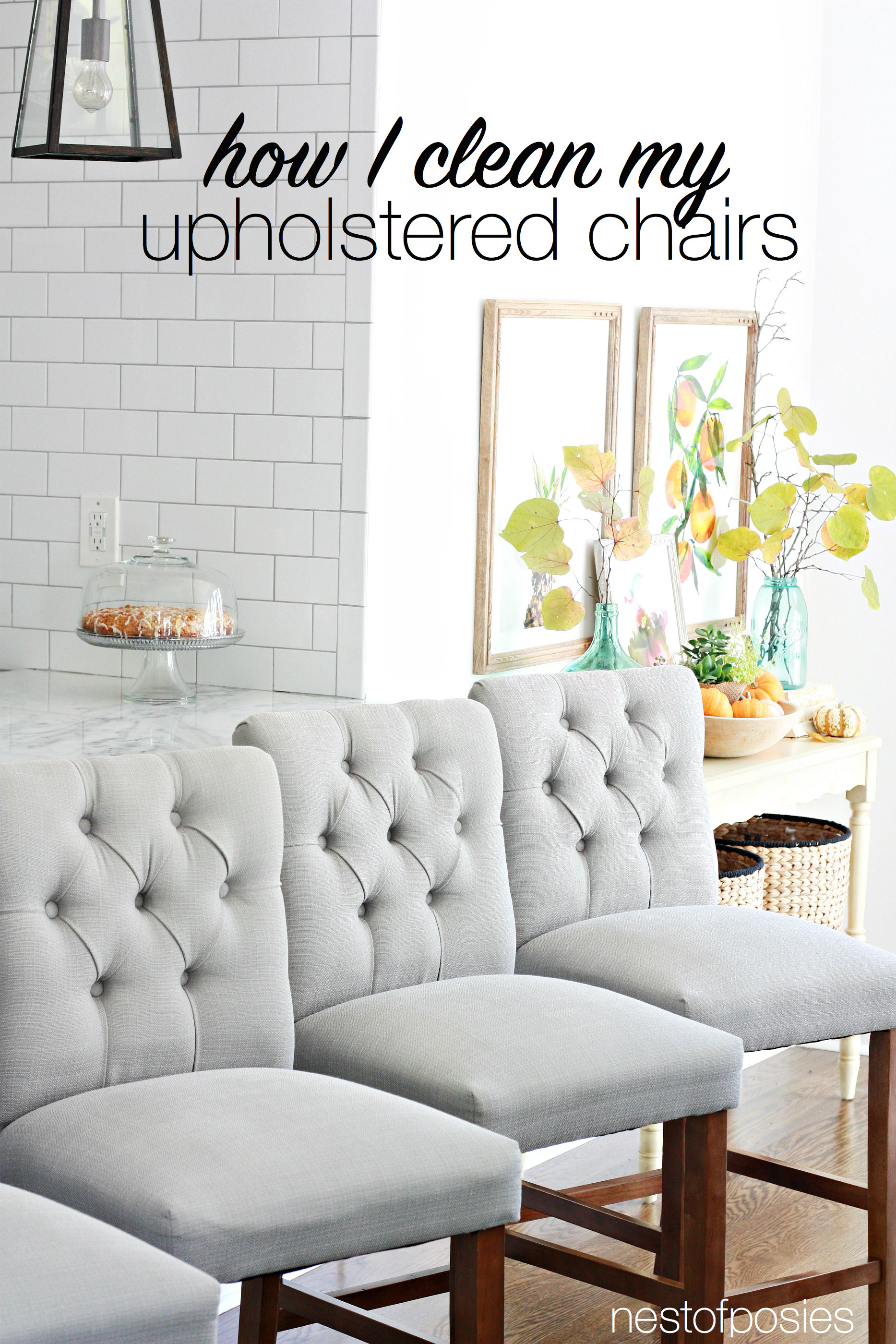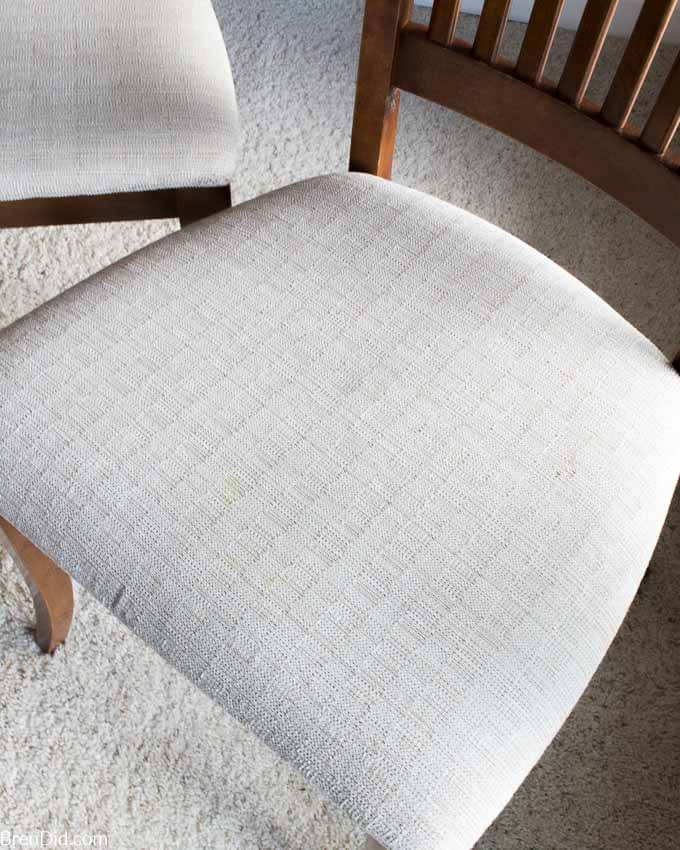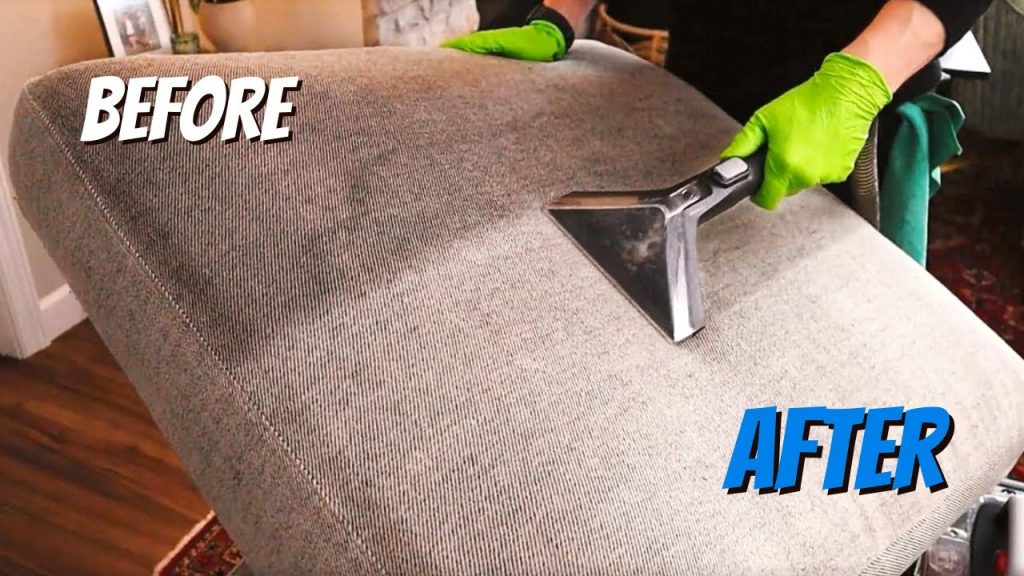Can I Use to Clean My Chair, use a vacuum, mild soap, and water for general upkeep. For specific materials, choose cleaners designed for leather, fabric, or metal.
Keeping your chair clean not only enhances its appearance but also prolongs its life and provides a pleasant sitting experience. Regular cleaning can prevent the build-up of dirt and allergens, contributing to a healthier environment. As different chair materials require different care, always check the manufacturer’s guidelines for recommended cleaning products and methods.
For everyday cleaning, a simple solution of mild detergent and water will suffice for most chairs, but for stubborn stains or delicate materials, specialized cleaners might be necessary. Remember to tackle spills immediately to prevent permanent damage. With proper maintenance, your chair can remain a comfortable and attractive feature of your home or office.

Introduction To Chair Cleaning
Clean chairs are not only inviting but essential for a healthy home or office environment. Think about how often chairs are used; they’re the silent supporters during meals, study sessions, and for those who work from home, a good portion of your day. This makes keeping them clean a priority for longevity and hygiene.
Importance Of Regular Chair Maintenance
Regularly maintained chairs last longer and look better. Dirt and grime can wear down the fibers in your chair’s fabric, and spills can turn into permanent stains if not treated promptly. Beyond looks, a clean chair can help reduce allergens like dust mites and pet dander. Keeping chairs clean also contributes to a more inviting atmosphere in any setting.
Understanding Different Chair Materials
Chairs come in many materials, and each requires a unique approach to cleaning. For instance, leather chairs need special cleaners to avoid damage, while fabric chairs can usually handle a wider range of cleaning products. Here’s a quick guide:
| Material | Cleaning Method |
|---|---|
| Leather | Use a damp cloth with mild detergent |
| Fabric | Vacuum and use fabric cleaner |
| Mesh | Gentle brushing and vacuuming |
| Wood | Wipe with a wood cleaner or a damp cloth |
| Plastic & Metal | Soap and water with a soft cloth |
Remember, always test a small, inconspicuous area first with your chosen cleaning method. This ensures that the material reacts well to your cleaning solution and technique.
Cleaning Fabric Upholstered Chairs
Keeping your fabric upholstered chairs clean is not just a matter of aesthetics but also extends the life and freshness of the furniture. Regular care ensures that your comfy seats remain inviting and tidy. The appropriate cleaning methods can remove dust, spills, and odors, rejuvenating your beloved chairs.
Vacuuming And Brushing Techniques
Vacuuming your chairs regularly prevents dust and dirt from settling deep into the fibers. Use a soft brush attachment to gently remove surface dirt.
- Attach the soft brush to the vacuum.
- Set the vacuum to a low setting.
- Gently glide over all fabric surfaces.
- Reach into crevices and corners.
For a more hands-on approach, brush with a fabric-safe bristle brush. This helps lift fibers and refreshes the material.
Spot Cleaning For Stains
Immediate spot cleaning can save your chairs from permanent stains. Always use a cleaner suitable for your chair’s fabric type. Blot stains, never rub, as this can spread the spot or damage the fabric.
- Gently blot excess liquid with a clean cloth.
- Apply fabric cleaner to another cloth.
- Dab the stained area with the cleaner.
- Rinse with a damp cloth.
- Allow the spot to air dry.
Deep-cleaning Solutions For Fabric Chairs
For a thorough cleanse, consider a fabric-friendly shampoo or upholstery cleaner. An annual or semi-annual deep clean maintains your chair’s appearance and hygiene.
- Check the manufacturer’s label for cleaning instructions.
- Test any cleaner on a hidden area.
- Use a soft sponge or cloth to apply the cleaner.
- Follow product directions for the best results.
- Rinse away any cleaner residue.
- Let the chair dry completely before use.
Steam cleaning is another excellent method for a deeper clean, though ensure your fabric can handle the heat and moisture.
Maintaining Leather Chairs
Leather chairs add a touch of elegance to any room, but they need proper care to stay in pristine condition. Regular maintenance not only keeps them clean but also preserves their quality and comfort over time. Learn how to dust, vacuum, condition, and manage spills on your leather furnishings for a lasting luxurious look and feel.
Dusting And Vacuuming Leather Surfaces
To keep leather chairs looking great, start with regular dusting. Use a soft microfiber cloth to gently wipe away dust particles. Avoid harsh brushes that can scratch the leather.
Vacuuming complements dusting. Attach a soft brush to the vacuum cleaner. Carefully go over all crevices and surfaces. This helps remove any hidden dust and dirt.
Conditioning And Protecting Leather
After cleaning, leather chairs need hydration. Use a quality leather conditioner. This nourishes the material, keeping it soft and preventing cracks. Apply it with a soft cloth, following the product’s guidelines. Conditioning should occur every 3-6 months for optimal protection.
- Choose a conditioner suitable for your leather type.
- Test the conditioner on a small area first.
- Apply evenly and allow it to absorb fully.
Addressing Spills And Stains On Leather
Spills happen, but quick action can prevent lasting damage. Blot spills immediately with a clean, dry cloth. Avoid rubbing as that can push the liquid deeper into the leather.
For stains, make a cleaning solution. Mix mild soap with water. Dip a cloth in the mix, wring well, and gently dab the stain. Rinse the cloth and wipe off soap residue from the chair. Dry the area with a clean cloth.
Never use strong detergents or bleach on leather. They can harm the finish and texture of your chair.
| Type of Stain | Cleaning Solution | Application Tip |
|---|---|---|
| Ink | Isopropyl alcohol | Gently dab on the stain |
| Grease | Baking soda | Apply and leave for a few hours |
| Wine | Soap and water mixture | Clean with a damp cloth |
Always test any cleaner on a small, hidden part of the chair first. Following these leather chair maintenance tips keeps your seating looking as good as new.

Caring For Wooden Chairs
Wooden chairs add beauty and warmth to any room. Proper maintenance is key to keeping them in good shape. Dusting, polishing, and attending to wear and tear helps preserve wood furniture. Learn the right ways to care for wooden chairs.
Dusting And Polishing Wood
Dusting is essential. Irregular dusting can scratch wood. Use a soft, dry cloth to wipe surfaces gently. For polishing, choose a product suitable for the wood type. Apply a thin layer. Use a dry cloth to buff the wood to a shine. This process enhances the wood’s natural beauty and protects the surface.
Avoid harsh chemicals that can damage the wood finish. Regular dusting and occasional polishing keep wooden chairs looking their best.
Dealing With Scratches And Scuffs
Scratches and scuffs can detract from the chair’s appearance.
- For light scratches, use a blend of oil and vinegar. Apply it to the scratch, then buff with a soft cloth.
- For deeper marks, consider a wooden furniture marker or crayon that matches the chair’s color.
- Apply the product to the affected area. Smooth it out with a soft cloth.
Regular inspections help spot damage early. Early treatment prevents further damage.
Using Wood Cleaners And Conditioners
Cleaning products designed for wood furniture care are important. Choose cleaners that won’t strip the wood’s natural oils. Lightly dampen a cloth with the cleaner. Gently work in sections, cleaning the surface.
After cleaning, apply a wood conditioner. This helps moisturize the wood. It also forms a protective layer against dirt and damage. Always dry the wood thoroughly after cleaning to prevent warping.
Dealing With Plastic And Metal Chairs
When it comes to keeping chairs clean, plastic and metal materials require their own special approach. Plastic chairs are lightweight and versatile. Metal chairs add a sleek look. But both need the right cleaning technique to stay in top shape. Let’s dive into how to keep them looking new.
Routine Cleaning For Plastic Chairs
Keeping plastic chairs clean is simple and can be done regularly. Use these steps for an effective clean:
- Mix a cleaning solution of warm water and mild dish soap.
- Wipe down the chairs with a soft cloth or sponge.
- Rinse with clean water to get rid of any soap residue.
- Dry with a soft towel to prevent water spots.
Rust Removal And Care For Metal Chairs
Metal chairs can get rust. Here’s how to tackle rust and maintain metal chairs:
- Identify any rust spots on the chair. Look carefully.
- Mix water and white vinegar in equal parts. Apply it to the rust.
- Scrub with a brush. Be gentle to avoid scratching.
- Rinse and dry the chair thoroughly after rust removal.
Preventative Treatments For Plastic And Metal Chairs
Preventing issues is better than fixing them. Protect your chairs with these tips:
| Material | Treatment |
|---|---|
| Plastic | Apply a UV protective spray to fend off sun damage. |
| Metal | Use a clear lacquer coating to shield against rust. |
Regular care helps your chairs last longer and keeps them looking great.

Eco-friendly Cleaning Options
Keeping your favorite chair clean doesn’t mean you have to use harsh chemicals. Eco-friendly cleaning options are not only better for the environment but often safer for your home and health. From natural agents to DIY mixes, a sustainable approach to chair care is within easy reach. Let’s explore some effective green solutions.
Natural Cleaning Agents For Different Chair Types
- Vinegar Solution: Ideal for upholstered chairs, it removes odors and light stains.
- Baking Soda: Great for fabric chairs. Sprinkle, let sit, then vacuum for freshness.
- Olive Oil & Lemon Juice: Perfect for wooden chair care. Polish and shine naturally.
- Castile Soap: Use on leather chairs for gentle, effective cleaning.
Diy Cleaning Recipes
| Ingredients | Method | Chair Type |
|---|---|---|
| 1 cup water, 1/2 cup vinegar, 2 tbsp baking soda | Mix, apply with cloth, wipe clean | Fabric Chairs |
| 2 parts olive oil, 1 part lemon juice | Blend, apply with a soft cloth, buff | Wooden Chairs |
| 5 drops Castile soap in water | Lightly mist, then wipe off with a soft cloth | Leather Chairs |
Sustainable Practices For Chair Care
- Choose biodegradable materials for cleaning cloths, like bamboo fibers.
- Implement regular dusting to minimize the need for deep cleaning.
- Adopt a no-shoes policy to keep chairs free from outside dirt.
- Use soft-bristle brushes to gently scrub without damaging the chair.
Tools And Equipment For Chair Cleaning
Clean and sparkling chairs enhance room aesthetics and offer a welcoming vibe. Regular care with the right tools keeps them looking great. This section breaks down all the chair cleaning essentials.
Essential Cleaning Tools
Vital chair-cleaning tools simplify the job.
- Microfiber cloths: Trap dirt and reduce scratches.
- Soft-bristle brushes: Gently remove debris.
- Vacuum cleaner with attachments: Clean nooks and crannies.
- Mild detergent or cleaning solution: Refresh upholstery without damage.
- Bucket: Mix cleaning solutions conveniently.
- Water hose or spray bottle: Offer a controlled water flow for fabric chairs.
Specialized Equipment For Different Chair Types
Chair variety demands specialized cleaning gear.
- Leather conditioner: Keeps leather supple.
- Upholstery shampooer: Deep cleans fabric chairs.
- Wood polish: Enhances wooden chair luster.
- Steam cleaner: An effective tool for sanitizing and removing stains.
Investing In A Professional Cleaning Kit
Consider a ready-made kit for thorough chair care.
| Kit Item | Usage |
|---|---|
| Professional-grade upholstery cleaner | Works on various fabrics. |
| High-quality leather cleaner | Cleans without fading. |
| Eco-friendly wood cleaner | Safe for frequent use. |
| Detailing brushes | Target tight spaces and crevices. |
A quality kit saves time, ensuring chairs stay in pristine condition.
Eliminating Odors And Freshening Up Your Chair
Chair odors can linger and make your living space less inviting. Over time, chairs can trap a host of smells from pets, spills, or everyday use. Fortunately, freshening up your chair and eliminating unpleasant odors is achievable with the right approach. DIY solutions and store-bought products offer effective methods for a refreshing transformation.
Home Remedies For Odor Removal
Common household items can be potent allies in your fight against chair odors. Here are some go-to remedies:
- Baking soda: Sprinkle generously over the chair, let sit for a few hours, then vacuum thoroughly.
- Vinegar spray: Mix equal parts water and white vinegar in a spray bottle. Mist lightly over the chair surface, avoiding saturation. Let air dry.
- Lemon juice: Add a few tablespoons to water and apply as a light mist for a fresh citrus scent.
Commercial Products For Freshening Chairs
If home remedies aren’t cutting it, consider these retail options:
| Product Type | Usage | Benefits |
|---|---|---|
| Enzymatic Cleaners | Apply as directed | Breaks down odor molecules |
| Fabric Fresheners | Spray lightly | Quickly neutralizes smells |
| Upholstery Shampoos | Use with a machine or by hand | Cleans deep and deodorizes |
Preventive Measures For Odor Control
Maintaining an odor-free chair involves regular upkeep. Follow these simple steps to prevent odors:
- Vacuum your chair weekly to remove dust and crumbs.
- Immediately clean up spills to avoid set-in odors.
- Use chair covers that can be easily washed.
- Keep the room well-ventilated to prevent musty smells.
Stain Removal Guide
Welcome to the ultimate Stain Removal Guide for chairs! No matter the mishap, this guide will help you clean up and keep your seating looking sharp. Say goodbye to unsightly spots and hello to spotless surfaces!
Identifying Types Of Stains
To tackle stains, first identify what you’re dealing with. Common culprits include:
- Food: May leave organic marks.
- Ink: Can be tricky, often a smear.
- Grease: Leaves slick, dark spots.
- Pet Stains: Might include odors.
- Beverage Spills: Coffee, wine, and juice are typical.
Stain Removal Techniques By Fabric Type
| Fabric | Cleaning Solution | Method |
|---|---|---|
| Leather | Mild soap, water | Wipe gently, dry immediately |
| Suede | Vinegar or alcohol | Blot, then brush fabric |
| Fabric Upholstery | Baking soda, water | Apply paste, vacuum off |
| Synthetic | Upholstery cleaner | Spray, then blot up |
| Velvet | Steam clean | Use steam, avoid pressure |
Always test a small, hidden area first to ensure no damage occurs.
When To Call A Professional For Stain Removal
Certain situations require expert care:
- Persistent Stains: After multiple attempts, if a stain remains.
- Delicate Fabrics: For materials like silk or antique textiles.
- Large or Dark Stains: Sizeable or deeply colored blemishes.
- Odor Removal: When a bad smell lingers.
Professionals have the tools and expertise to restore your chair without damage.
Preventive Care And Tips
To keep your chair in prime condition, regular upkeep is key. Opt for gentle cleaners. Be mindful of the materials.
With the right preventive care, a chair can last for years. Let’s dive into how to make that possible.
Regular Maintenance Schedule
Set reminders for cleaning intervals. Here’s a simple routine:
- Weekly: Dust off surfaces.
- Monthly: Vacuum fabric areas.
- Quarterly: Deep clean and condition.
Adjust the schedule based on usage.
Protective Measures For Chair Longevity
Adopt these habits:
- Use coasters: Prevent liquid stains.
- Avoid direct sunlight: Minimize fading and drying.
- Relocate periodically: Ensure even wear.
Regularly inspect for damage. Address issues promptly.
Educating Others On Chair Maintenance
Share knowledge with housemates. Teach them proper care practices. Create a friendly guide. Post it near the chair.
| Who | Task | Frequency |
|---|---|---|
| Kids | Clean up spills | Immediately |
| Guests | Use coasters | Always |
| All | Rotate seating | Monthly |
Encouraging collective responsibility keeps chairs clean and intact.
Troubleshooting Common Cleaning Challenges
Troubleshooting Common Cleaning Challenges often comes down to knowing the right techniques and products. Whether you’re facing stubborn stains, faded upholstery, or minor scrapes, don’t fret. Here’s how to tackle these issues and keep your chair looking as good as new.
Addressing Difficult Stains
Spills and spots on chairs can be a pain. To effectively remove them:
- Identify the stain type, whether it’s ink, wine, or grease.
- Use a specific cleaner that’s safe for your chair’s fabric.
- Blot, don’t rub, to avoid spreading the stain.
- Test a small area first to ensure no discoloration occurs.
Remember, patience is key. Repeat the process if needed, and always dry the area completely.
Restoring Faded Colors And Materials
Faded chairs can lose their appeal. To revive their color:
- Clean the chair thoroughly to remove any dust or grime.
- Use a fabric revitalizer designed for the material of your chair.
- If safe, expose the chair to sunlight briefly to brighten the colors.
This may not bring back the original luster, but it will improve the chair’s appearance.
Repairing Minor Damage During Cleaning
Cleaning can sometimes reveal minor damages. Here’s what to do:
| Type of Damage | How to Repair |
|---|---|
| Snags or loose threads | Carefully trim or reweave them. |
| Small tears | Use a fabric repair kit or patches. |
| Fading | Apply a color-safe fabric dye. |
Minor fixes like these can make your chair look great again without much effort.
Conclusion And Best Practices
Keeping chairs clean is not just about appearance but also about longevity and hygiene. By adhering to the right techniques and approaches, anyone can maintain their chairs in top-notch condition. Below is a recap of effective methods, tips to embrace, and errors to avoid, followed by the encouragement of regular cleaning routines.
Recapping Effective Cleaning Methods
To sum up the cleaning process, here’s what to remember:
- Identify the material of your chair before starting.
- Use a vacuum for loose debris.
- Mild soap and water work well for general cleaning.
- For specific materials, use specialized cleaners like leather conditioner or upholstery shampoo.
- Test any cleaner on a small hidden area first.
Final Tips And Common Mistakes To Avoid
Follow these final pieces of advice to ensure your chair stays spotless:
- Always dry your chair completely to prevent mold and mildew.
- Avoid harsh chemicals that might damage the fabric.
- Never skip the manufacturer’s instructions for care and cleaning.
- Do not over-wet upholstered chairs, as this can lead to prolonged drying times and potential damage.
Encouraging Regular Cleaning Habits
Regular cleaning not only keeps chairs looking great but also extends their life. Aim for:
| Frequency | Action |
|---|---|
| Daily | Wipe down surfaces and clear debris. |
| Weekly | Vacuum and spot clean as needed. |
| Monthly | Deep clean with appropriate products. |
Embrace these habits and enjoy a fresh, clean seating area.
Frequently Asked Questions On What Can I Use To Clean My Chair
What Is The Best Cleaner For Leather Chairs?
Upholstered leather chairs benefit from cleaners specific to leather. Use a gentle, moisturizing soap or a leather conditioner. Simple solutions like diluted white vinegar work too. Always test on an inconspicuous area first.
Can Vinegar Damage Fabric Chairs?
Vinegar is safe for most fabric chairs if diluted properly. Mix one part vinegar with two parts water. Don’t soak the fabric. A misting spray bottle works well for even application.
How Often Should I Clean My Office Chair?
For hygiene and longevity, clean your desk chair every 3 to 6 months. If used daily, you may need to clean it more frequently. Wipe down surfaces and vacuum upholstered parts regularly.
Are Diy Chair Cleaners Effective?
DIY cleaners can be effective and are often budget-friendly. Common ingredients include baking soda, vinegar, and mild dish soap. They’re best for light cleaning and must be tested on a small area.
Conclusion
Cleaning your chair doesn’t have to be a chore. With the right tools and solutions, it can be done quickly and effectively. Remember to consider your chair’s material before selecting a cleaning agent. Embrace regular maintenance to extend your chair’s life and keep your seating inviting and spotless.
Happy cleaning!

